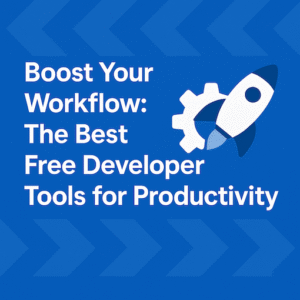In the modern world of constant notifications, multitasking, and digital noise, finding focus as a programmer has become more difficult than ever. Yet, deep focus is the cornerstone of great software development. A clean, distraction-free coding environment isn’t just about minimal aesthetics — it’s about optimizing your mental bandwidth to solve complex problems effectively.
In this article, we’ll break down how to design a coding setup that minimizes distractions and maximizes productivity — from hardware and software tools to habits and environmental design.
1. Why Focus Matters More Than Ever
Programming is a cognitively demanding task. Every interruption — a Slack ping, an email alert, a context switch — can cost you up to 20–25 minutes to regain full focus.
That’s why a distraction-free workflow isn’t a luxury, it’s a productivity multiplier.
Deep work allows you to:
- Write cleaner, more maintainable code.
- Solve harder problems faster.
- Enter the “flow state” where coding feels effortless.
- Reduce burnout caused by constant context switching.
2. Start With the Physical Environment
Your physical setup has a direct impact on how your brain operates.
Minimalist Desk Setup
- Keep only what’s necessary: your laptop/monitor, keyboard, and mouse.
- Use cable management clips or trays to declutter.
- Avoid mixing work and leisure gear (e.g., gaming controllers or personal phones).
Lighting and Ergonomics
- Natural light boosts alertness and reduces fatigue.
- Use a 5000–6500K white light source to mimic daylight.
- Position your monitor at eye level to reduce neck strain.
Sound and Focus
- Noise-canceling headphones are a must-have for open workspaces.
- Try focus playlists (like Lo-Fi Beats or Coding Mode on Spotify).
- If you prefer silence, use earplugs or apps like Noisli to create ambient soundscapes.
3. Optimize Your Digital Workspace
Even with a great desk setup, digital clutter is often the biggest distraction.
Use a Minimal IDE Setup
- Disable unnecessary extensions and UI elements in your code editor.
- Try Zen Mode (available in VS Code, JetBrains IDEs, etc.).
- Keep one terminal and one browser window open per project.
Choose Tools That Reduce Friction
- Window managers: Magnet (macOS) or PowerToys FancyZones (Windows) for tidy layouts.
- Clipboard managers: Paste, Maccy, or Clipy for faster copy-paste workflows.
- Automation tools: Raycast or Alfred to execute commands without touching the mouse.
Block Digital Distractions
- Browser extensions like LeechBlock, StayFocusd, or Freedom.
- Focus timers such as Pomofocus or Toggl Track.
- Mute notifications during deep work sessions using Do Not Disturb mode.
4. Design a Productive Workflow
Your tools can help, but structure and routine make the difference between busywork and productivity.
Timeboxing & Deep Work Blocks
- Schedule 90-minute coding sessions with full focus.
- Use Pomodoro (25–5 min intervals) if you struggle with long blocks.
- Plan demanding tasks during your energy peak (often mornings).
Context Switching Management
- Batch similar tasks: code review sessions, bug fixes, meetings.
- Close unrelated tabs and IDE projects before starting new work.
- Keep notes in a dedicated system (like Obsidian or Notion) to offload mental clutter.
5. Mental Cleanliness = Code Cleanliness
Focus isn’t just about tools — it’s about mindset.
Cultivate Mindful Coding
- Start each session with a clear goal: “I’ll refactor the API module.”
- Take short walks between focus blocks to reset attention.
- Avoid late-night coding marathons; rest improves creativity.
Balance Work and Life
A clean workspace means little if your mind is overwhelmed. Regular exercise, adequate sleep, and time offline will boost your problem-solving abilities more than any productivity hack.
6. Your Programmer Toolbox for Focus
Here’s a compact list of tools to help you stay distraction-free:
| Category | Recommended Tools |
|---|---|
| IDE | VS Code (Zen Mode), JetBrains (Distraction-Free Mode) |
| Automation | Raycast, AutoHotKey |
| Time Tracking | Toggl Track, RescueTime |
| Noise Control | Krisp, Noisli |
| Task Management | Notion, Todoist |
| Focus Blocking | Freedom, Cold Turkey |
Final Thoughts
A distraction-free coding environment is a combination of space, software, and self-discipline. It doesn’t mean isolating yourself — it means designing a workflow where your attention is respected and your creativity can flourish.
Remember: you can’t control how long the world will distract you, but you can control how well you protect your focus.




